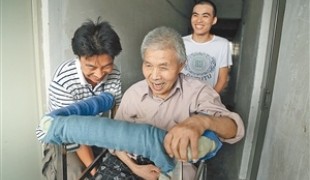- 6466
- 432
- 3
- 7
- 0
- Help Ukraine
About the solution
The device is removable: it can be tilted backwards when transferring into or out of the wheelchair and adjusting according to the size of the person. It was built for an electric wheelchair, but it can be adapted to any type of wheelchair.
Despite his condition, Michel kept drawing, using his mouth, and then with the assistance of computer technology. He designed the plans to adapt a system for relieving the shoulder joint, which is heavily used by wheelchair users to maintain a good position.
The inventor died in early 2016, it was one of his sisters, Christine Moulin, shared this solution online posthumously.
Adapted from: http://bit.ly/2nMOz3e
这些解决方案不应包括使用药物,化学品或生物制品(包括食品);创伤性设备;冒犯性的,商业或内在危险的内容。该解决方案未经医学验证。请谨慎进行!如果您有任何疑问,请咨询健康专家。
DISCLAIMER: This story was written by someone who is not the author of the solution, therefore please be advised that, although it was written with the utmost respect for the innovation and the innovator, there can be some incorrect statements. If you find any errors please contact the patient Innovation team via info@patient-innovation.com
-
-
414
-
0
-
6533

Boy develops walker for his grandfather
MOVING IN A WHEELCHAIR: Moving using a wheelchair.
BODY BALANCE: Maintaining body balance
Hemiplegia
Brain Injury (Abscess, Brain Barrier Defect, Brain Contusion, Brain Hemorrhage, Brain Edema)
Paralysis
Brain Stroke
Assistive Daily Life Device (to help ADL)
Walking Aid (wheelchair/walker/crutches)
Chest pain or discomfort
Muscle cramps or spasms
Difficulty coordinating movements
Paralysis of the legs and lower body
Muscle weakness
Fatigue
Dizziness or lightheadedness
Numbness or weakness in the legs
Fainting or loss of consciousness
Irregular heartbeat (arrhythmia)
Cold hands or feet
Rapid heartbeat (tachycardia)
Shortness of breath
Chest tightness/pressure
Restoring mobility
Managing Neurological Disorders
Maintaining Balance and Mobility
Cardiology
General and Family Medicine
Neurology
Orthopedics
China
-
-
-
328
-
0
-
5507

Scooter for disabled people
MOVING IN A WHEELCHAIR: Moving using a wheelchair.
CAREGIVING
Amyotrophic Lateral Sclerosis
Assistive Daily Life Device (to help ADL)
Walking Aid (wheelchair/walker/crutches)
Gait abnormalities (e.g., walking difficulties, unsteady gait)
Muscle cramps or spasms
Difficulty coordinating movements
Stiffness or rigidity (difficulty moving)
Paralysis of the legs and lower body
Muscle weakness
Fatigue
Restoring mobility
Promoting self-management
Rehabilitating After Stroke
Managing Neurological Disorders
Promoting inclusivity and social integration
Preventing (Vaccination, Protection, Falls, Research/Mapping)
Caregiving Support
Neurology
Orthopedics
Rheumatology
United States
-
-
-
481
-
0
-
8332

Boys create chair for disabled friend
MOVING IN A WHEELCHAIR: Moving using a wheelchair.
Studying
Cerebral Palsy
Neuromuscular Disorders
Muscular Dystrophy
Spinal Cord and Nerve Root Disorders
Walking Aid (wheelchair/walker/crutches)
Assistive Daily Life Device (to help ADL)
Muscle cramps or spasms
Difficulty coordinating movements
Stiffness or rigidity (difficulty moving)
Paralysis of the legs and lower body
Muscle weakness
Restoring mobility
Managing Neurological Disorders
Promoting inclusivity and social integration
Caregiving Support
Medical Genetics
Neurology
Orthopedics
Belgium
-
 zh
zh